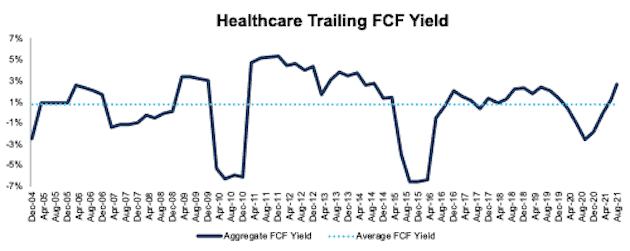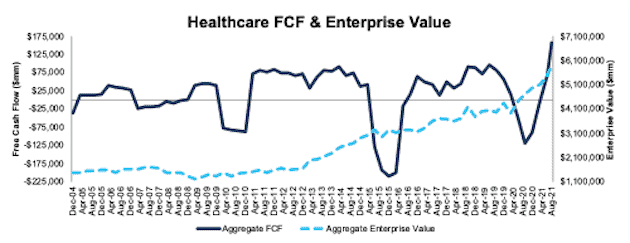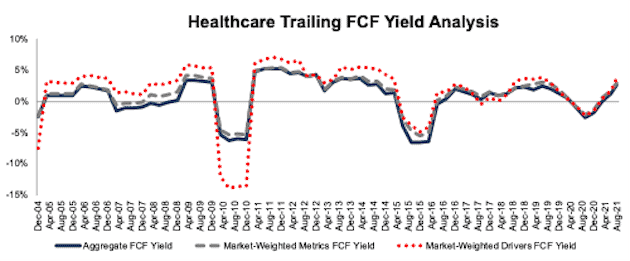This report is an abridged and free version of S&P 500 & Sectors: Free Cash Flow Yield Through 2Q21, one of the reports in our quarterly series on fundamental market and sector trends, available to Pro and higher members. More free reports on the fundamental trends for the overall market and each sector are available here
The full version of this report analyzes[1] free cash flow (FCF), enterprise value, and the trailing FCF yield for the S&P 500 and each of its sectors (last quarter’s analysis is here). Our research is based on the latest audited financial data, which is the 2Q21 10-Q for most companies. Price data is as of 8/18/21.
These reports leverage more reliable fundamental data[2] that overcomes flaws with legacy fundamental datasets. Investors armed with our research enjoy a more informed view of the fundamentals and valuations of companies and sectors. Investors armed with our Core Earnings data feed enjoy idiosyncratic alpha.
S&P 500 FCF Yield Continues Rebound in Q2 2021
The trailing FCF yield for the S&P 500 rose from 0.8% in 2Q20 to 1.9% as of 8/18/21, the earliest date all S&P 500 companies provided 2Q21 data. See Figure 1 in the full version of our report for the chart of FCF Yield for the S&P 500 from December 2004 thru 2Q21. Seven S&P 500 sectors saw an increase in trailing FCF yield year-over-year (YoY) based on 2Q21 financial data, as we’ll show below.
Key Details on Select S&P 500 Sectors
Investors are getting more FCF for their investment dollar in the Basic Materials sector than any other sector. On the flip side, the Telecom Services sector currently has the lowest trailing FCF yield of all S&P 500 sectors.
The Healthcare, Industrials, Energy, Telecom Services, Utilities, Real Estate, and Basic Materials sectors each saw an increase in trailing FCF yield from 2Q20 to 2Q21. Below, we highlight the Healthcare sector, which had the largest year-over-year increase in FCF yield of all S&P 500 sectors.
Sample Sector Analysis[3]: Healthcare
Figure 1 shows trailing FCF yield for the Healthcare sector rose from -2.5% in 2Q20 to 2.7% in 2Q21. The Healthcare sector FCF rose from -$120 billion in 2Q20 to $156 billion in 2Q21, while enterprise value rose from $4.7 trillion in 2Q20 to $5.9 trillion in 2Q21.
Figure 1: Healthcare Trailing FCF Yield: December 2004 – 8/18/21
Sources: New Constructs, LLC and company filings.
The August 18, 2021 measurement period uses price data as of that date and incorporates the financial data from 2Q21 10-Qs, as this is the earliest date for which all the 2Q21 10-Qs for the S&P 500 constituents were available.
Figure 2 compares the FCF and enterprise value trends for the Healthcare sector since 2004. We sum the individual S&P 500/sector constituent values for free cash flow and enterprise value. We call this approach the “Aggregate” methodology, and it matches S&P Global’s (SPGI) methodology for these calculations.
Figure 2: Healthcare FCF & Enterprise Value: December 2004 – 8/18/21
Sources: New Constructs, LLC and company filings.
The August 18, 2021 measurement period uses price data as of that date and incorporates the financial data from 2Q21 10-Qs, as this is the earliest date for which all the 2Q21 10-Qs for the S&P 500 constituents were available.
The Aggregate methodology provides a straightforward look at the entire S&P 500/sector, regardless of market cap or index weighting, and matches how S&P Global (SPGI) calculates metrics for the S&P 500.
For additional perspective, we compare the Aggregate method for free cash flow with two other market-weighted methodologies: market-weighted metrics and market-weighted drivers. These market-weighted methodologies add more value for ratios that do not include market values, e.g. ROIC and its drivers, but we include them here, nonetheless, for comparison. Each method has its pros and cons, which are detailed in the Appendix.
Figure 3 compares these three methods for calculating the Healthcare sector’s trailing FCF yields.
Figure 3: Healthcare Trailing FCF Yield Methodologies Compared: December 2004 – 8/18/21
Sources: New Constructs, LLC and company filings.
The August 18, 2021 measurement period uses price data as of that date and incorporates the financial data from 2Q21 10-Qs, as this is the earliest date for which all the 2Q21 10-Qs for the S&P 500 constituents were available.
This article originally published on August 27, 2021.
Disclosure: David Trainer, Kyle Guske II, Alex Sword, and Matt Shuler receive no compensation to write about any specific stock, style, or theme.
Follow us on Twitter, Facebook, LinkedIn, and StockTwits for real-time alerts on all our research.
Appendix: Analyzing Trailing FCF Yield with Different Weighting Methodologies
We derive the metrics above by summing the individual S&P 500/sector constituent values for free cash flow and enterprise value to calculate trailing FCF yield. We call this approach the “Aggregate” methodology.
The Aggregate methodology provides a straightforward look at the entire S&P 500/sector, regardless of market cap or index weighting, and matches how S&P Global (SPGI) calculates metrics for the S&P 500.
For additional perspective, we compare the Aggregate method for free cash flow with two other market-weighted methodologies. These market-weighted methodologies add more value for ratios that do not include market values, e.g. ROIC and its drivers, but we include them here, nonetheless, for comparison:
- Market-weighted metrics – calculated by market-cap-weighting the trailing FCF yield for the individual companies relative to their sector or the overall S&P 500 in each period. Details:
- Company weight equals the company’s market cap divided by the market cap of the S&P 500/ its sector
- We multiply each company’s trailing FCF yield by its weight
- S&P 500/Sector trailing FCF yield equals the sum of the weighted trailing FCF yields for all the companies in the S&P 500/sector
- Market-weighted drivers – calculated by market-cap-weighting the FCF and enterprise value for the individual companies in each sector in each period. Details:
- Company weight equals the company’s market cap divided by the market cap of the S&P 500/ its sector
- We multiply each company’s free cash flow and enterprise value by its weight
- We sum the weighted FCF and weighted enterprise value for each company in the S&P 500/each sector to determine each sector’s weighted FCF and weighted enterprise value
- S&P 500/Sector trailing FCF yield equals weighted S&P 500/sector FCF divided by weighted S&P 500/sector enterprise value
Each methodology has its pros and cons, as outlined below:
Aggregate method
Pros:
- A straightforward look at the entire S&P 500/sector, regardless of company size or weighting in any indices.
- Matches how S&P Global calculates metrics for the S&P 500.
Cons:
- Vulnerable to impact of companies entering/exiting the group of companies, which could unduly affect aggregate values. Also susceptible to outliers in any one period.
Market-weighted metrics method
Pros:
- Accounts for a firm’s market cap relative to the S&P 500/sector and weights its metrics accordingly.
Cons:
- Vulnerable to outlier results from a single company disproportionately impacting the overall trailing FCF yield.
Market-weighted drivers method
Pros:
- Accounts for a firm’s market cap relative to the S&P 500/sector and weights its free cash flow and enterprise value accordingly.
- Mitigates the disproportionate impact of outlier results from one company on the overall results.
Cons:
- More volatile as it adds emphasis to large changes in FCF and enterprise value for heavily weighted companies.
[1] We calculate these metrics based on S&P Global’s (SPGI) methodology, which sums the individual S&P 500 constituent values for free cash flow and enterprise value before using them to calculate the metrics. We call this the “Aggregate” methodology. Get more details in Appendices I and II.
[2] For 3rd-party reviews, including The Journal of Financial Economics, on our more reliable fundamental data, historically and prospectively, across all stocks, click here and here.
[3] The full version of this report provides analysis for every sector like what we show for this sector.



